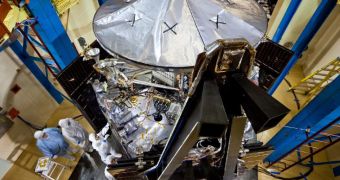The upcoming mission that NASA has planned for studying Jupiter is currently beginning to take shape in the labs of Denver, Colorado-based Lockheed Martin Space Systems (LMSS). The company is the main contractor the space agency selected to build the orbiter.
At this point, the vehicle is undergoing environmental testing. The goal of these investigations is to assess its readiness to fly in space starting August 5, 2011, which is when its launch window opens.
Juno is completely assembled and integrated at this point, officials with the American space agency announce. It will take off from the Cape Canaveral Air Force Station (CCAFS), in Florida.
This spacecraft will be powered by solar panels, and plans are to have it make at least 33 orbits around the Jovian poles. The goal of the mission is to gain a deeper understanding of the planet's origins, structure, atmosphere and magnetosphere.
All scientific payloads, thrusters, engines, fuel tanks and avionics equipments have already been installed and prepped for launch. The vehicle is currently in its latest stages of testing before being shipped to Florida for mating with its delivery system.
The January 26 image attached to this article shows the spacecraft shortly after engineers ran an acoustical test, meant to simulate the conditions Juno will experience during launch. At that time, its environment will consist mostly of vibrations and sound waves.
Lockheed Martin engineers decided to test the space probe with all of its three solar panel wings installed and folded inside their special compartments, and also with the high-gain communications antenna already mounted on top of the chamber containing the avionics equipment.
Currently, the company is keeping the vehicle inside a large thermal vacuum chamber, that will further simulate the conditions the spacecraft will experience once it reaches space. It will undoubtedly face a harsh road attempting to reach Jupiter, and its builders want to ensure it can overcome all obstacles.
Two weeks from now, when its taken out of the vacuum chamber, it will be packed and sent to the NASA Kennedy Space Center (KSC) for final preparations. The Center is right next to the CCAFS.
The principal investigator of the Juno mission is expert Scott Bolton, who is based at the Southwest Research Institute (SwRI), in San Antonio, Texas. The mission is managed by the NASA Jet Propulsion Laboratory (JPL), in Pasadena, California.
Also involved in constructing Juno is the Italian Space Agency (ISA), headquartered in Rome. Its experts built the infrared spectrometer instrument on the space probe, as well as a portion of the radio science experiment equipment onboard.

 14 DAY TRIAL //
14 DAY TRIAL //